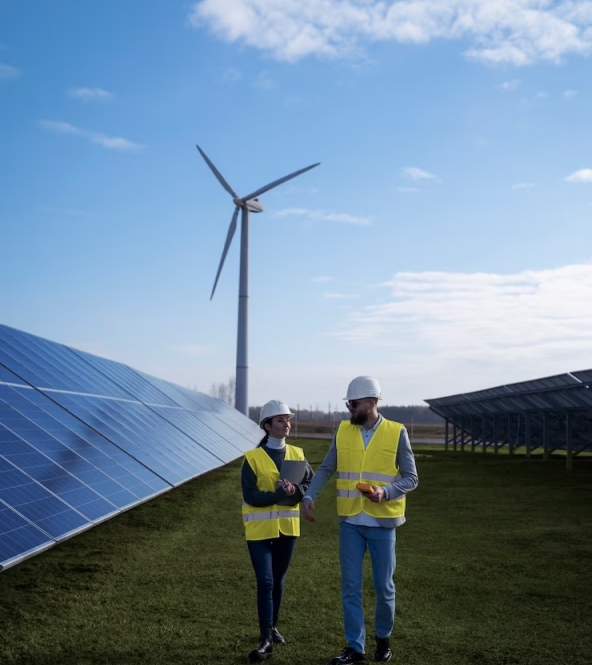Tilted vs. Flat Solar Panels: What You Need to Know?

If you are contemplating installing a solar panel system at your home or business, one of the crucial decisions you will face is over flat vs tilted solar panels. While one adds to aesthetic appearance, the another ensure optimum performance.
However, the decision between both solar panels relies on numerous factors like budget, location, orientation and climate conditions. Any wrong move can hamper your solar system efficiency in the long run. So, how do you determine the right solar panel direction and angle for your solar panel?
To clear doubts, we have prepared this article. It will explore the advantages and considerations of tilted and flat solar panel configurations. And try to shed light on how the solar panels’ angle of installation impacts energy efficiency. So you can make the right choice.
How Does The Angle Of Installation And Direction Impact Solar Panel Efficiency?
Before we debate over solar panels flat vs angled, let’s first understand why angle makes such a difference.
Solar panel systems rely on sunlight for their functioning. The better the sun exposure the solar panel receives and absorbs, the more power you will get.
However, the tilt or angle of solar panel installation plays a crucial role in solar panel functioning. If the panels are angled correctly, they can catch more sunlight as it moves across the sky. It means they work more efficiently and produce more energy over time.
Similarly, solar panel direction is another crucial factor that affects your solar PV system output. With Australia in the southern hemisphere, you should ensure your solar panels will face north for more solar exposure.
By considering both the angle and direction of your solar panels, you can ensure they deliver more efficiency all year round.
Flat Solar Panels
Flat solar panels are installed horizontally to your roof surface without the need for any supporting structures or poles. It makes flat solar panels a viable choice if you have a flat roof and want to save on upfront costs.
Advantages of Flat Solar Panels
-
Aesthetics and Ease of Installation
In solar panels flat vs angled comparison, flat solar panels overpower later with their simple and easy installation process. This seamless integration with the rooftops offers a sleek and aesthetic look to your home or business.
-
Affordable
Flat solar panels are installed easily with less mounting material, reducing the upfront cost and making it a vital choice for budget-conscious customers.
-
Easy Maintenance
When comparing flat vs tilted solar panels, maintenance plays a crucial role. With a flat surface and no curves or angles that allow debris and dirt to accumulate, you can easily clean and maintain these panels for maximum performance.
-
Versatile Placement
You can install these panels on numerous surfaces, such as roofs, ground or facades. This way, you can utilise the available space effectively and locate the best surface for solar panel installation.
Tilted Solar Panels
Installing Solar panels at an angle helps them to optimise the maximum sunlight they absorb, making tilted solar panels an ideal option. Also, you can adjust their angle according to the sun’s path and geographical location to enhance the efficiency of solar panels.
Advantages of Tilted Solar Panels
-
Increased Energy Production
When comparing solar panels flat vs angled, the angled is considered a better choice because of its ability to generate more energy output. With the feature of tilting the panels at appropriate angles, tiled solar panels can capture more sunlight, offering you increased efficiency and more electricity production.
-
Adaptability
If your roof lacks an ideal direction and angle for solar exposure, tilted solar panels are one of the best choices.
-
Better Self Cleaning
The angle of tilted solar panels gives them a slope for the natural shedding of dust, dust or debris, making them win the debate over flat vs tilted solar panels in the cleaning aspect. Moreover, the rainwater can easily wash away the accumulated dust particles, adding to the optimum performance of your solar system.
-
Seasonal Adjustments
Some tilted solar panels come with manual or automatic adjustability features, allowing you to adjust your solar modules according to the seasons. So you can enjoy maximum efficiency throughout the year.
Key Considerations for Solar Panels Flat Vs Angled
1. Location
When considering flat vs tilted solar panels, you must evaluate your decision based on the location of your home or business. The solar panel angle equal to your location’s latitude offers maximum energy production.
2. Budget
While comparing solar panels flat vs angled, flat solar panels are a budget-friendly option. With their easy installation, few mounting accessories requirements and simple design, you don’t need to spend much on installation and maintenance. On the other hand, tilted solar panels require additional expenses incurred in installing mounting racks and labour costs.
3. Available Space
If you have limited roof space, consider installing flat solar panels because they use less space vertically. However, tilted solar panels are suitable if you have sufficient roof space, offering more energy output and better space usage.
4. Roof type
Your roof type is also a factor in selecting solar panels flat vs angled. Tilted solar panels are ideal for roofs with no specific sun exposure and angle, while flat solar panels work best when your roof has a natural tilt towards the sun.
Conclusion
We hope this article cleared your doubts on flat vs tilted solar panels. By understanding the advantages and considerations of both panels, you can opt for the one that offers you maximum energy output.




